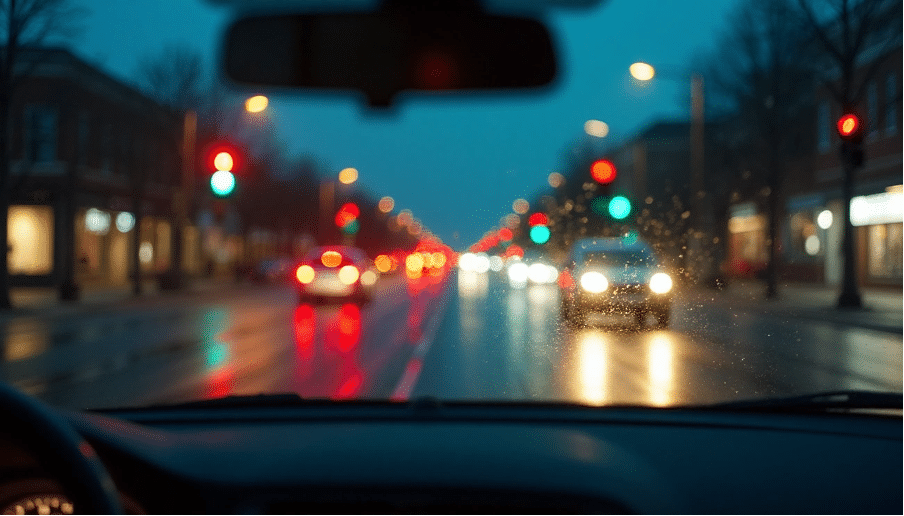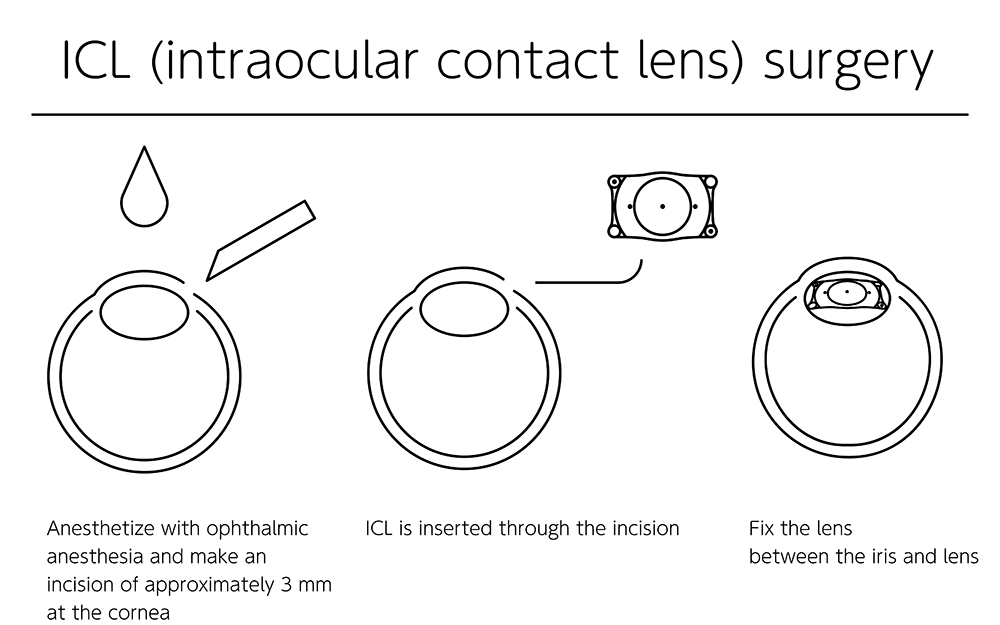About one in three people face challenges with night driving due to astigmatism. You might have this common vision condition if you see blurry images, halos around traffic lights, or starburst patterns while driving at night. Your cornea and lens are affected by astigmatism, which creates distortion that becomes worse in dark conditions.
Your pupils get bigger at night to let in more light, which makes astigmatism’s effects more noticeable. Light scatters more through your dilated pupils because of your cornea’s uneven surface. This creates annoying halos and glare that make driving at night stressful and possibly unsafe. Many people notice blurry vision, tired eyes, headaches, and poor night vision that makes them squint while driving. But you don’t need to deal with unclear vision after dark if you get the right diagnosis and treatment. This piece shows how astigmatism affects your ability to drive at night and offers several solutions – from special glasses to surgery – that can help turn your blurry road vision into clear sight.

Recognising the Signs of Astigmatism at Night
Can’t see well after dark? Night driving might feel more challenging because of astigmatism. The sort of thing I love about vision health is how common yet misunderstood it can be. About 30% of people develop astigmatism at some point. This condition becomes much more noticeable in low-light conditions.
Blurry vision and squinting
Blurry or distorted vision stands out as astigmatism’s main sign that affects objects both near and far. Your vision gets worse at night as your pupils expand to capture more light. This expansion lets extra peripheral light enter your eye and causes more blur. You might catch yourself squinting while driving to see better. Your face muscles naturally try to compensate but end up tired from all that squinting.
Halos and glare around lights
Bright headlights look like they have rings or starbursts around them? Light scatters instead of focusing right because of your irregular cornea shape. Drivers who have astigmatism often see what looks like “comets” with streaks of light coming from street lamps and car lights. On top of that, bright lights might seem too intense or create streaky patterns in your vision.
Eye strain and headaches
Your eyes work extra hard to focus with astigmatism and that leads to real discomfort. Eye muscles tighten up too much as they try to work around the irregular cornea shape, which makes them tired. These tired eyes often trigger headaches, especially after you drive in the dark. The mix of squinting, trying to read road signs, and dealing with bright lights creates the perfect recipe for tired eyes that bug you even after you get home.
When to seek an eye exam
Night vision problems getting you down? Book your eye consultation with Precision Vision London today to find lasting solutions for astigmatism. The NHS suggests getting professional help if you shows signs of astigmatism or hasn’t had an eye check in the last two years. You should get an immediate eye exam if night vision issues affect your daily tasks like driving. The Academy of Ophthalmology recommends yearly eye exams for everyone over 40. Keep in mind that you need to see an eye doctor right away if your vision changes suddenly or night driving becomes harder.
How Astigmatism Affects Night Driving Specifically
Night driving with astigmatism creates unique challenges that go beyond regular problems in the dark. The physics behind these vision issues explains why many drivers don’t feel safe on roads after sunset.
Light scattering due to corneal shape
Your eye’s structure causes most night driving difficulties. People with astigmatism have a cornea that resembles a football or egg shape rather than the ideal basketball-like curve. This uneven curve makes light entering your eye focus on multiple points instead of one spot on your retina. Light from headlights, traffic signals, and street lamps scatters unevenly through your visual field. This creates those distinct visual distortions that make nighttime driving difficult.

Why symptoms worsen in low light
Your pupils naturally dilate when darkness falls to let in more light. This biological response helps people with normal vision see better at night, but it makes things worse for those with astigmatism. Wider pupils allow more peripheral light rays to pass through the uneven cornea. The extra light exposure makes the scattering effect stronger and creates more noticeable blurring, halos, and starbursts around lights.
Comparison of normal vs. astigmatic night vision
Normal and astigmatic night vision differences are dramatic. People without astigmatism see headlights as clear, defined points of light in the darkness. These same lights look like blurred, stretched shapes with radiating lines that resemble comets for those with astigmatism. Research shows that untreated astigmatism reduces night driving performance by a lot. Drivers struggle to read road signs, notice hazards, and see pedestrians. Astigmatism can also lower contrast sensitivity, which makes it hard to spot objects against dark backgrounds.
Vision Correction Options for Night Driving
The difference between stressful and confident night driving comes down to finding the right vision correction solution. Several treatments can help manage astigmatism after dark, from basic corrective eyewear to advanced surgical options.
Glasses with anti-glare lenses
Anti-reflective coatings on prescription glasses cut down headlight glare when you drive at night. Treatments like UltraClear SuperClean reduce distracting reflections and keep your lenses cleaner and scratch-resistant. Your night vision becomes sharper without those frustrating halos when you use specialised lenses that properly redirect light to your retina, especially with severe astigmatism.
Toric contact lenses for better focus
Toric lenses are designed specifically to help people who prefer contact lenses deal with astigmatism. Research shows these lenses substantially improve driving safety at night. Mild astigmatism might work fine with ordinary gas-permeable lenses, but higher degrees need toric soft lenses that match your eye’s unique shape.
LASIK for astigmatism: what to expect
LASIK surgery reshapes your cornea permanently, and over 99% of patients achieve 20/20 vision or better. The procedure’s track record shows rare serious complications, though you might experience temporary side effects like dry eyes for weeks or months.

ICL surgery for astigmatism: a permanent fix
Implantable Collamer Lenses (ICLs) are another permanent solution that works great with higher prescriptions. Clinical studies show 93% of patients come within ±1.00D of their target prescription twelve months after surgery. About 74% achieve 20/20 or better vision without any correction.
Customised treatment at Precision Vision London
Night vision problems getting you down? Book your eye consultation with Precision Vision London today and discover lasting solutions for astigmatism. Precision Vision London’s treatments are unique and personally designed for each patient. Dr. CT Pillai’s clinic specialises in finding and fixing why astigmatism happens. Their complete approach has a year-long aftercare programme, and you’ll have a surgeon with you throughout your whole treatment experience.
Lifestyle Adjustments for Safer Night Driving
Practical lifestyle adjustments can substantially improve your night driving experience with astigmatism, beyond medical corrections.
Avoid driving when tired
Tiredness makes astigmatism symptoms worse while driving. People with normal vision see things blurry when exhausted, all the same this effect hits harder with astigmatism. Your safest option is to pull over right away and rest if your vision blurs or drowsiness sets in. ROSPA studies show that 40% of road traffic collisions occur at night, and proper rest could prevent many of these accidents.

Image Source: CNET
Dim interior lights
Bright dashboard lights create harsh contrasts with the dark outside, making your eyes work harder to adjust. Lower GPS brightness and interior control lighting helps match external conditions. This simple change reduces eye strain and helps you focus better on the road ahead.
Use rewetting drops for dry eyes
Winter months typically worsen dry eye syndrome. Research from 2022 revealed that dry eyes affected driving in nearly 30% of people with the condition, while only 15% of those without it reported issues. Contact lens wearers should pick rewetting drops made specifically for their lenses and stay away from products with preservatives.
Practise safe driving habits
Astigmatism brings challenges, but these practical steps help:
- Clean your windscreen, mirrors and glasses often to cut down light scatter
- Position rearview mirrors to reduce headlight glare from behind
- Keep extra distance between cars for more reaction time
- Learn routes beforehand if night driving makes you uncomfortable
Conclusion
Astigmatism shouldn’t stop you from driving at night or force you to deal with poor vision. This piece explores how astigmatism affects your vision, especially when you have those annoying halos, blurriness, and glare that make night driving tough. These symptoms get worse after sunset as your pupils dilate and let more scattered light pass through your irregularly-shaped cornea.
The good news is you have several solutions to tackle these vision challenges. Anti-glare glasses, toric contact lenses, LASIK surgery, and ICL procedures can help you see better. Each option brings different benefits based on your needs and lifestyle priorities.
Simple changes can also make your night driving better. You can reduce visual stress by dimming interior lights, using rewetting drops, and keeping your windows clean. These practical steps combined with the right vision correction can turn your driving from stressful to confident. Note that getting the right diagnosis is crucial to deal with astigmatism. A complete eye examination helps specialists understand your astigmatism’s exact nature and suggest the best treatment.
Precision Vision London’s team is here to help you through this experience with personalised care and advanced technology. Dr. CT Pillai and the expert team create custom treatment plans and provide complete aftercare. Your vision concerns get full attention from your first visit through recovery. You should have clear, comfortable vision day and night. Don’t let astigmatism stop you from driving after dark. Take action today to get sharper night vision and feel confident behind the wheel again.
Key Takeaways
Understanding astigmatism’s impact on night driving can help you identify symptoms and seek appropriate treatment for safer, clearer vision after dark.
- Astigmatism causes halos, starbursts, and blurred vision around lights due to irregular corneal shape that worsens when pupils dilate at night.
- Multiple correction options exist, from anti-glare glasses and toric contact lenses to permanent surgical solutions like LASIK and ICL procedures.
- Simple lifestyle adjustments like dimming interior lights, using rewetting drops, and avoiding tired driving significantly improve night vision comfort.
- Professional eye examination is essential for proper diagnosis, with treatment success rates exceeding 99% for achieving functional vision through modern procedures.
- Combining medical correction with practical driving habits transforms night driving from a stressful experience into confident, safe travel after sunset.
FAQs
Q1. How does astigmatism affect night driving? Astigmatism can make night driving challenging due to blurred vision, halos around lights, and increased glare from headlights. These effects are more pronounced at night because pupils dilate in low light, allowing more scattered light to enter the eye.
Q2. What do headlights look like to someone with astigmatism? For people with astigmatism, headlights often appear as blurred, elongated shapes surrounded by streaks or starbursts. This distortion is more noticeable at night due to the stark contrast between light sources and darkness.
Q3. Can I still drive if I have astigmatism? Yes, you can drive with astigmatism, but it’s important to have proper vision correction. Uncorrected astigmatism can make night driving particularly challenging due to increased blurriness and light distortion in low-light conditions.
Q4. What are some effective treatments for astigmatism to improve night driving? Several options can help, including glasses with anti-glare lenses, toric contact lenses, LASIK surgery, and ICL (Implantable Collamer Lens) procedures. The best solution depends on your specific condition and should be determined after a comprehensive eye examination.
Q5. Are there any practical tips to make night driving easier with astigmatism? Yes, some helpful strategies include dimming your dashboard lights, keeping your windscreen clean, using rewetting drops for dry eyes, and avoiding driving when tired. It’s also important to have regular eye check-ups and ensure your vision correction is up to date.
Authors & Reviewer
-
 Olivia: Author
Olivia: AuthorHi, I'm Olivia, a passionate writer specialising in eye care, vision health, and the latest advancements in optometry. I strive to craft informative and engaging articles that help readers make informed decisions about their eye health. With a keen eye for detail and a commitment to delivering accurate, research-backed content, I aim to educate and inspire through every piece I write.
-
 Dr. CT Pillai: Reviewer
Dr. CT Pillai: ReviewerDr. CT Pillai is a globally recognised ophthalmologist with over 30 years of experience, specialising in refractive surgery and general ophthalmology. Renowned for performing over 50,000 successful laser procedures.


